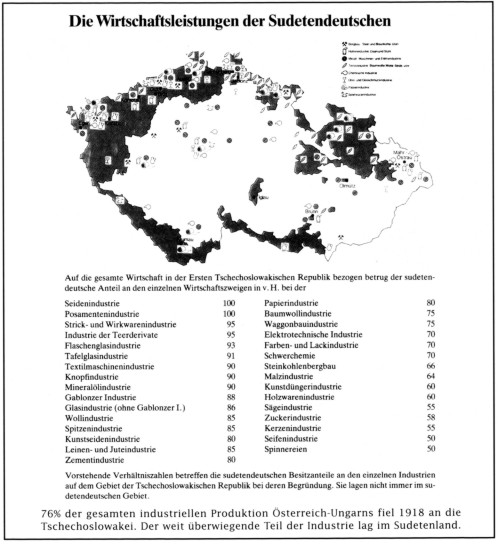|
13.
The industrialization
During
the 19th century, economic development increasingly determined
the fate and politics of the Sudetengermans. Entrepreneurship
of the middle class, a good combination of inventiveness,
circumspection and boldness made especially the
North-Bohemian-Silesian people the forerunners of industrial
progress. From early on, Sudetengerman businessmen and their
co-workers participated in the development of technical
innovations and began the building of machinery in their own
land. Tremendous upswings took place in the Glass, porcelain
and cloth industries. The '40s saw the beginning of railroad
construction and public transportation facilitating the
development of various manufacturing centers: Reichenberg -
cotton and wool products, Trautenau and Mährisch-Schönberg -
linenware, North-Moravia - silkware, Ore-Mountains - lace
fabrics and toys of wood, Graslitz and Schönbach - musical
instruments, Iser-Mountains - glass manufacture,
Eagle-Mountains - spinning, brush making, West-Bohemia - wood
and mother-of-pearl products, Southern Bohemian Forest - wood
carving, Brüx/Dux and Giant Mountains - metal products,
Aussig - the major chemistry complex in Central Europe,
North-Bohemia - hosiery manufacture, Elbe-Valley - soap,
candle and fat-surrogate manufacture, Bodenbach - chocolate
products, Teplitz - largest plate glass manufacturing center
in Europe, Maffersdorf - internationally known manufacture of
weaved and knotted carpets. The Czech regions predominated in
the manufacture of products based on agriculture, such as
sugar, alcohol, beer and so on. The hard coal deposits at
Kladno and Mährisch-Ostrau (Ostrava) provided
a favorable basis for heavy industry.
The
industrialization was accompanied by a rapidly rising
employment of low-wage labor, Czech as much as German. During
the earlier years,
this "fourth class" had to cope with dismal living
conditions. Wages were low, bread almost a luxury and housing
dreadful. The worst conditions prevailed in the coal mining
regions. The
Sudetengerman workers had the good fortune that many of the
established crafts remained dependent on home labor. As
difficult as it was to subsist on a minimal income, they were
capable of preserving their families and retaining the
attachment to their homes. Actual slums did not develop in the
Sudetenland. Wage earners often tended a garden and kept goats
and sometimes a pig.
The
Sudetengerman share of industrial property
in Czechoslovakia |
|

|
The share of the listed
industrial properties owned by
Sudetengermans in relation to the total of
these properties in the Czechoslovak
Republic amounted to (in %):
|
| Silk
products industry |
100 |
|
Paper
industry |
80 |
| Textile
trimmings manufacture |
100 |
|
Cotton
processing industry |
75 |
| Knitting
ware manufacture |
95 |
|
Rail-car
manufacture |
75 |
| Tar-based
industries |
95 |
|
Electrotechnical
industry |
70 |
| Bottle-glass
manufacture |
93 |
|
Lacquer
and paint industry |
70 |
| Plate-glass |
91 |
|
Inorganic
chemical industry |
70 |
| Textile
machinery manufacture |
90 |
|
Hard
coal mining |
66 |
| Button
manufacture |
90 |
|
Malt
production |
64 |
| Mineral
oil-based industry |
90 |
|
Fertilizer
manufacture |
60 |
| Glass
jewelry |
88 |
|
Wood
products industry |
60 |
| Other
glass products |
86 |
|
Saw
manufacture |
55 |
| Wool
processing industry |
85 |
|
Sugar
manufacture |
58 |
| Lace
manufacture |
85 |
|
Candle
manufacture |
55 |
| Silk-surrogate
industry |
80 |
|
Soap
manufacture |
50 |
| Linen
and jute industry |
85 |
|
Spinning
mills |
50 |
| Cement
industry |
80 |
|
|
|
|
| |
| The listed figures refer to
portions of properties within the
Czechoslovak Republic owned by
Sudetengermans at the time the
proprietorships were founded. Not all were
located in German-populated regions. |
| 76 %
of the total industrial production
facilities of Austria-Hungary fell to
Czechoslovakia in 1918. Most
of these properties were located in the
Sudetenlands. |
|
Unfortunately,
the industrialization transformed and spoiled portions of the
countryside also in the Sudetenlands. Natural water supplies
got polluted and forests suffered overexploitation. Also, the
character farming villages underwent lasting changes. Loud
noise and smoke filled the tranquil valleys. What the
ancestors had created, the descendents often ruined wantonly
in the name of the modern age. No wonder that socialistic and
communistic ideas took hold among the working people. With
Ferdinand Lassalle the political workers' movement began to
spread. Associations were founded for mutual support,
education, and also as groups similar to trade unions.
Radicalism appeared too, which at first hampered the
development of the workers' movement. Later on the Social
Democratic Party emerged from these movements and found strong
support, especially among the Sudetengermans. Since 1897, the
Social Democrats were represented in the Reichsrat. The living
conditions had improved in the meantime.
|